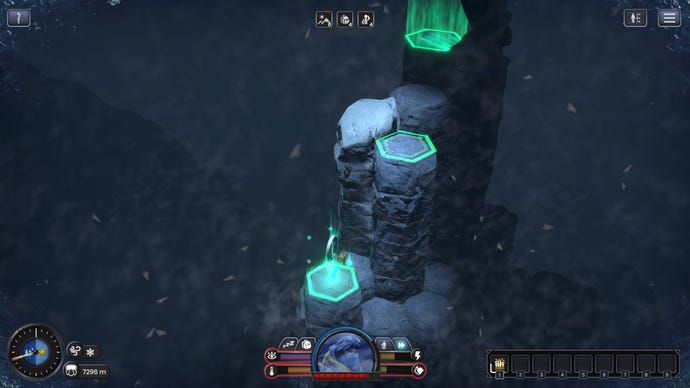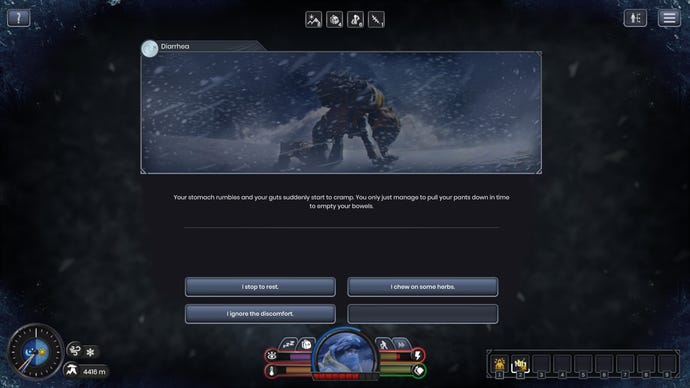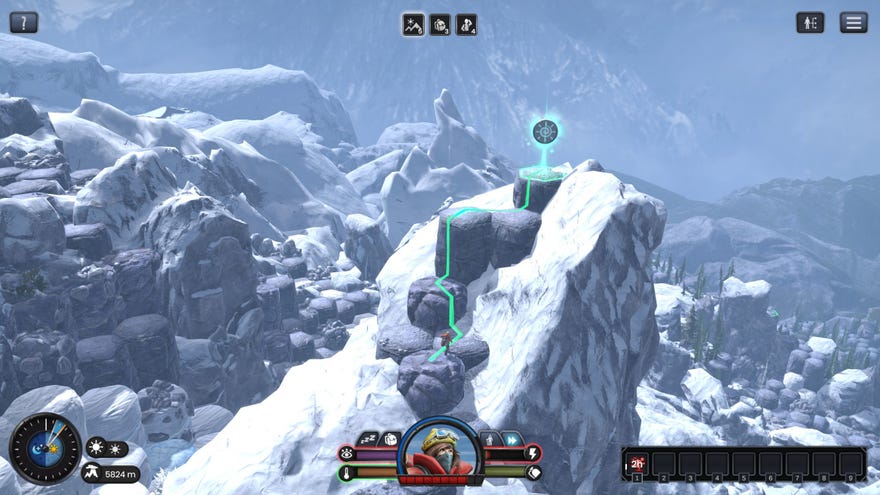Insurmountable review: a clever roguelike about mountaineering
Built to scale
Everything I know about mountain climbing came from a corporate team-building day where management hired a banker who’d scaled Everest to tell us how he left most of his group to die in order to reach the summit. This wasn’t a guilty confession. Apparently there comes an altitude where halting becomes so dangerous that it dooms any dawdlers. You carry on going or expire on the spot. As the then editor of a failing games magazine I couldn’t see any reading of the metaphor where I wasn’t the struggler and my website peers weren’t being told to leave me. Hilariously, this was not the bleakest moment of the day (that was some nervous guy from IT bellowing “Show me the money!” to win book tokens or similar bullshit).
What stuck with me is how all or nothing a climb could be, something you commit to until you either get a killer anecdote or end as another speck of colourful polyester in Rainbow Valley. In this sense, Insurmountable’s decision to equate mountaineering with a survival roguelike is astute: one life, one run, all the while coping with the random luck or misfortune dealt by an unpredictable landscape. This is not a polite hobby where you bank your progress for another day, and in this sense the do or die of a roguelike run feels more honest than the hilly simulations of Death Stranding or myriad VR climbing walls currently available. Just as a concept, I want to celebrate the cleverness of it all.
It works by breaking the mountain into hexagonal tiles, which has a weird side effect of rendering each peak as a towering mound of Giants Causeway basalt or something out of the next Halo game. Tiles are rock, snow or ice, which affects the stamina drain of crossing them, and have varying degrees of stability, which raises the odds of an accident occurring. Then there’s also the issue of height difference, with a heavy stamina cost for scaling taller cliffs, enough to encourage you to clamber up more forgiving baby steps instead. Well, as long as you don’t mind taking a longer route, which means more time in a place that is draining your heat, sanity and, at greater heights, oxygen.
I’m always surprised how rough it gets up here - that it’s called the Death Zone should have been a clue.
It's when one of these four meters hits zero that critical events start triggering with regularity, battering that all-important health bar. From my runs it splits into a game of two halves. At lower levels, the riskiest stat is stamina, as that requires sleep to replenish, and napping on the mountain turns you into a human popsicle if you don’t have a cave or a tent, which only has limited uses. You also don’t want to be hitting caves during the day - you want to sleep away the nights, as everything drains faster and the mountain is visually obscured - or in friendlier weather, which should always be exploited for a few extra hours of unmolested hiking.
On normal difficulty this is reasonably forgiving, relaxing even, as you soak in the ambient calm and make smooth progress between narrative event tiles. These let you gamble time or stamina for a chance to discover an XP-rich story nugget or pry a thermos of coffee from the hands of the dead. Go on, make that sociopathic banker proud. With the right perks - unlocked as you level up - and lucky equipment drops, it’s reasonably easy to find replenishing loops on this gentle ascent, freeing you to pillage every narrative tile, amassing thermoses (thermi?) and oxygen tanks for the harsh heights.

Hit the death zone, however, where the air thins, and the oxygen meter finally comes into play, and with it a complete shift in mentality. Now every nap or detour is sucking precious O2 from your tank and, unless you lucked into several spares lower down, it’s going to push you into riskier shortcuts and the misfortune only piles up from there. Even on a well prepared climb, with generous equipment drops and your desired perks, I’m always surprised how rough it gets up here - that it’s called the Death Zone should have been a clue. It’s a really effective bit of drama, and instils a juicy dose of fear for future runs.
I’m less sold on the overall campaign structure. You tackle three peaks in succession, with permanent debuffing ‘scars’ carrying over between climbs. These injuries seem random and can be ruinous: several times I’ve had an extra oxygen cost when moving, which is basically a death sentence. Just as a time investment, we’re talking about a couple of hours of careful navigation that’s easily nuked by a twist of fate on the final peak. I think you accumulate enough trauma on each climb that having the option to restart the second or third peak upon death would still make for a decent challenge, or at least a friendlier tier for beginners.
Part of the problem is that success is so closely tied to methodically mining safer territory. It makes for naturally slow moving runs, and quite unexciting ones when it’s being played efficiently. What I’d give for the option for your climber to auto-equip the most suitable clothing for any tile. As it is, you get into ludicrous scenarios where you are re-equipping on a tile by tile basis to optimise - perhaps not essential on normal difficulty, but a micromanaging necessity on anything higher. That’s a lot of fiddly inventory icon dragging every ten seconds. An idea that should have definitely been left to die in the snow.

I think the game could also be more explicit about how its own route suggestions optimise time over stamina use - before I cottoned on to that simple fact, my runs were being cut short time and time again. Get into the habit of plotting tile-to-tile journeys and your success shoots up. Of course, now I’ve told you and they don’t need to patch it. Although, on that, the team does seem receptive to criticism and keen to tweak; already since release they’ve added more event tiles (much needed, I was sick of seeing the same goat again and again) and given character classes unlockable skills for the start of a run - a much needed foothold.
It’s only the journalist that comes to the mountain without a tent.
Oh, and a quick note on the characters. I love that of the three - adventurer, scientist and journalist - it’s only the journalist that comes to the mountain without a tent. This captures the writer mindset perfectly. Frankly I’m amazed their entire inventory doesn’t just consist of Kendal Mint Cake. That’s all I brought with me when my Scout troop visited Snowdonia. I made it about an hour of hiking before I got tired, made a fuss and got to sit the climb out in the troop minibus.
So, again: I’m probably not the best person to rate the physical ins and outs of a mountain climbing game. But as a consumer of pop culture tales of derring-do, and a horrified audience member to that callous motivational speaker, I dig ByteRockers attempt to find the right genre fit for the singular, intense mindset of a potentially lethal hobby.



